The History of the Norfolk Terrier

The Norfolk Terrier has always been a ratter...
In the ‘drains’ of their native land, East Anglia (see: Eileen Needham’s Short History of the Norfolk, below), they have excelled in keeping the rat population down.
It is interesting that in the early days, great pride was taken in their being ‘game’. There is even a certificate from a Master of Foxhounds the East Essex Hunt, in 1932, that Tobit was ‘entered to badger and is game’. In today’s climate of antipathy towards hunting, plus the horror of badger baiting, this seems somewhat grotesque, as a badger can kill a small terrier with one bite. It is also of course illegal. Foxes are also mentioned, but even they are a mismatch with a Norfolk and not his natural quarry.
The present day Norfolk, still an ardent ratter, retains all his hunting instincts, but the emphasis has changed from the ideal of being ‘game’ to being a sweet natured companion - but still a terrier. Of course no prints of the Norfolk by name exist from the last centuries but these scenes give a good idea of our breed’s ancestors and their activities.
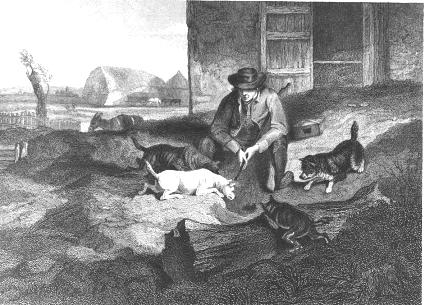


The Skye Terrier. The Scotch Terrier.
The English Smooth Terrier.
The Crossed Scotch Terrier.
The Dandie Dinmont. The Bull Terrier.
Probably terriers such as these were among the early forbears of the Norfolk.

Attractive terriers of Norfolk type have always been around so it is not surprising that, in time, these dogs were developed into a recognised breed.
One of these pictures was first published in Joan Read’s book ‘The Norfolk Terrier’.
Our thanks go to Mrs Bee Ege (Chidley Norfolks USA), for finding these prints.
A SHORT HISTORY OF THE NORFOLK TERRIER
© Eileen Needham
The present day Norfolk Terrier began life as a show breed in 1932 when, as the drop-eared Norwich Terrier, it was accepted on the Kennel Club breed register, but it is interesting to look at its possible evolution.
East Anglia, that part of south-east England which bulges out into the North Sea extending from The Wash to the Thames Estuary, is particularly flat and low (many inland places still at only sea-level), and contained, at one time, in the northern Norfolk and Cambridgeshire parts of this area, large marshes known as “The Fens”. These fens were largely drained in the sixteenth century by Dutch engineers. As a result, the area is covered by a network of canals, known locally as “drains”. The land is fertile and is now an important arable farming region, producing most of the country’s cereal crops. Historically, small terrier-type dogs were popular amongst the farming and sporting community to use on rats and other vermin. It is possible that some of these terriers were the forerunners of the early Norwich Terrier.
During the nineteenth century some of the Undergraduates at Cambridge University bought small terrier dogs from a dog dealer named Charles (Doggy) Lawrence. These small terriers, which were often red or a black and tan colour, were used mainly for catching rats around the colleges. They became known as Trumpington Terriers, taking the name from the street in Cambridge where many students lived. Their origin is not really known but there is a suggestion that a small Irish Terrier and a bigger type of Yorkshire Terrier had been used in their breeding.
At that time Mr. Jodrell Hopkins, of Trumpington Street, Cambridge, bought a small brindle, Aberdeen-type, terrier bitch, and mated her to a game little red dog, which had a long silky coat, belonging to Doggy Lawrence. A puppy from that union, Rags, was given to a Mr. Jack Cooke, Master of the Norwich Staghounds. Rags was a small red terrier with a shaggy, harsh, red coat and prick ears (although in those days many terriers had their ears cropped). He was a wonderful worker and an excellent sire.
Mr. Lewis (Podge) Low, the son of a local veterinary surgeon, was keen on a good terrier, and owned a smooth-haired, white, prick-eared bitch called Ninety. He had several litters from her sired by Rags.

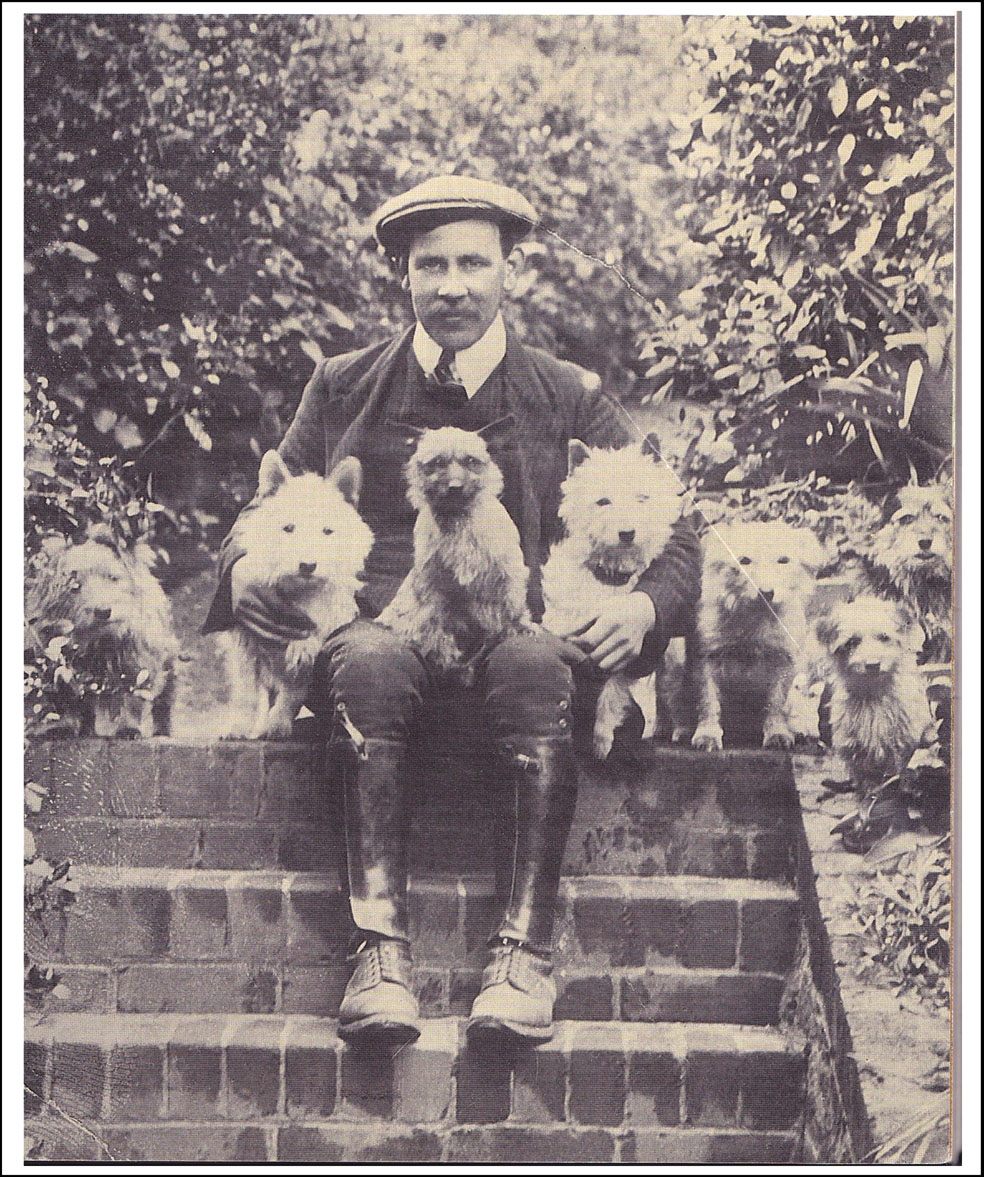
All the puppies were red, and some were bought by Mr. Frank Jones, First Whip to the Norwich Staghounds. He found them to be in great demand amongst the local sporting fraternity, and so he began to breed them himself. Later, when he went to work as a roughrider to a Mr. Stokes of Market Harborough, he became known as "Roughrider Jones". He sold his terrier pups far and wide, some being exported to America, where they became known as "Jones Terriers".
One of Jones' sources of supply was the stud groom to Mr. Jack Cooke, Mr. Horace Cole by name, who had bred several litters out of a small, wirehaired terrier bitch, and sired by one of Cooke's Trumpington Terriers. Interestingly, Mr. Cole's daughter, Mrs. Rosie Panks, started to breed Norwich Terriers herself in 1935.
In trying to establish the type he wanted, Jones crossed his stock with other terriers he fancied. Mr. R.J. Read (later to become the Breed Club's first President) bought a puppy in 1909 from a litter by Rags out of Ninety, and he also went on to experiment in breeding to get the sort of terrier he wanted. He used a Bedlington Terrier to obtain more drive, and later, a brown (see note) Staffordshire Bull Terrier bitch from a strain which he admired belonging to the Countess of Kimberley to correct the Bedlington coat. From this he crossed to a small Irish Terrier and then bred back to Mr. Jack Cooke’s strain, eventually producing, in 1929, "Horsted Mick". At about the same time Mr. W.E. West began his “Farndon” line with a bitch from Roughrider Jones and, in 1912, Mrs. Fagan also began with a bitch called Brownie whose dam, Flossie, red with a black back, was very game. Many famous names can be traced back to Brownie.

So, the foundations of the show Norwich were being established. There appeared to be no actual planning of a new breed, breeders simply mating their bitches to Rags' line because they liked the type and colour of the offspring. They continued with their efforts to breed true to that type.
Following Kennel Club recognition in 1932, the breed was scheduled first at Richmond Championship Show, where fourteen dogs were entered and Best of Breed going to Mrs. Fagan's Smudge, a dark grizzle and tan prick-ear (also described as black-backed by Mrs. Fagan), a grandson of Brownie, and the sire later of the first drop ear champion, Mrs. NormandyRodwell's Champion Airman's Brown Smudge, a male bred in 1932. Smudge, incidentally, also sired the first prick -eared bitch champion, Ch. Miss Manette, also bred and owned by Mrs. Fagan.
The first actual champion in the breed, Ch. Biffin of Beaufin, was owned by Mrs. E. Mainwaring, who liked her terriers to have their ears dropped, and, as Biffin wanted to prick his ears it is said she weighted them to keep them down. Biffin has had an influence on the breed as a whole, both ear types being able to trace back lines to him.

Another early drop-ear breeder was Mrs. Guy Blewitt of the “Boxed” prefix. She owned a famous dog called Tobit, a wonderful ratter. She also had the distinction of breeding the second drop-eared champion, Tinker Bell, whelped in 1933.

With the advent of shows following Kennel Club recognition, ears became all important, many breeders preferring the prick-ears and, indeed, some members of the Breed Club Committee did try to insist that only prick-ears should be recognised. Interbreeding between the two types of ear carriage did continue for a time but, eventually, breeders kept to one or other of the ear types. Even in the thirties the breed had begun to divide, and by the end of the 1940s there were very few Norwich with mixed ear-carriage breeding in the first two or three generations.
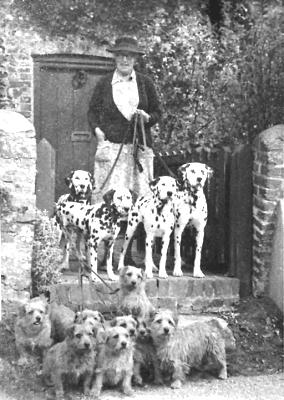
Miss Marion Sheila Scott Macfie, breeder of the “Colonsay” Dalmatians, joined the Norwich Terrier Club in 1935. She preferred the drop-ears and founded her Colonsay Norwich on Mrs. Mainwaring's Tiny Tim of Biffin, and the Hon. Mrs. Brooke's Kinmount Pip. Miss Macfie bred and showed extensively and successfully, and it is largely due to her efforts that the drop-ears were kept going in such strength throughout the years of World War II.

When championship shows started up again after the War, the Norwich, going into the ring untrimmed (and often ungroomed as well) did not look like show dogs, and it was the prick-ears who were winning most Challenge Certificates and beginning to make the most progress.


Although there were a few outstanding drop-ears in the late 1950-60s, with a winning pair owned by Miss Macfie, Ch. Colonsay Orderley Dog with 19 C.C.s and Ch. Colonsay Banston Belinda with 12 C.C.s, (a record at that time for a bitch), and which remained unbroken until recent times, drop-ear entries went down until, in 1964, they were only about a quarter of those of the prick-ears.

Miss Macfie had already begun a campaign to give each type a separate register within the one breed, but it took seven years before the two types actually achieved separate recognition in 1964. Although the Club had wanted separate registers within the one breed, the Kennel Club had insisted on two separate breeds being formed, with different names. The more dominant prick-ears kept the name "Norwich Terrier", and, after some debate, it was agreed that the drop-ears should become the "Norfolk Terrier".

Quality amongst the drop-ears at that time was poor, and there was little in the way of any breed type. However, new and enthusiastic breeders and exhibitors began to join the established kennels, and all worked hard through the years to achieve their common goals to produce the typy, sound, showy Norfolk Terriers we see today, and which can hold their own in all-breed championship show competition.
Note: “Brown” is not a recognised colour in Staffordshire Bull Terriers at the present time.
* * *
“A Short History of the Norfolk Terrier” by © Eileen Needham, is taken, in part, from the following articles and information:
-The Early History of the Norwich Terrier: compiled from information supplied by early breeders
(The Norwich Terrier Club Year Book 1932)
-Further light on the possible origin of the Norwich Terrier: by Monica (Joy) Taylor
(The Norwich Terrier Handbook 1960)
-Early Days: by Sheila Monckton
(The Norwich Terrier Club Hand Book 1960)
-The First Twenty five Years: by Marjorie Bunting.
An account of the history of the show Norfolk since recognition as a separate breed in 1964.
(The Norfolk Terrier Club Handbook 1989).
The Lead up to Separation
by Marjorie Bunting
Reproduced from the 1968 Norfolk Terrier Club Handbook.
Why ‘The Norfolk’ ?
FROM the very beginnings of the breed which was accepted by the Kennel Club in 1932 as the Norwich Terrier, both prick-eared and drop-eared terriers were crossed to achieve the type which the early breeders were seeking. Until it became illegal to do so, most ears were cropped, and when it was no longer possible to do this, the majority of the breeders attempted to breed for prick-ears. However, ear-carriage was not really of the first importance to those early breeders and, except for the odd fanatic, so long as the terrier was hardy, good tempered and game, ear-carriage did not arouse any very strong feelings.
With Kennel Club recognition this situation changed and ears suddenly became all important. Many of the first show breeders preferred the prick-ears, but the drop-ears which had appeared over the years had a following and although both the President (Mr R J Read) and Secretary (Mrs Normandy-Rodwell), plus some of the Committee members, did try to bring into the standard an insistence that only the prick-ears should be recognised, or at least that they should have preference over the drop-ears, the drop-ear breeders had their way and the first standard read thus as regards ears: - “Ears, if erect, slightly larger than a Cairn’s : if dropped, very neat and small and correctly dropped.”
In those early show days some breeders were still mating drop-eared bitches to prick-eared dogs and vice-versa, but it was not long before it was realised that this led to doubtful ear-carriage and even when an individual dog’s ears were correctly carried, the breeders found that they could never be sure what would happen to the ears in the next generation, which made breeding an extra hazardous business. This in turn led to breeders sticking to one type of ear-carriage or the other and so it can be seen that as early as the 1930s the breed had started to seriously divide and by the end of the next decade there were very few Norwich Terriers with mixed ear-carriage breeding in the first two or three generations.
When shows re-commenced after the war it was soon obvious that the prick-ears were to be the dominant partner so far as major awards went, and this situation inevitably led to a flare up between breeders of the two types, which was to last, off and on, until official division of the breed by the Kennel Club in 1064.
On many occasions over the years from about 1948 onwards, breeders of each type had wordy battles in the canine press as to which was the original type; whether the prick-ears made for a smarter appearance; whether those with erect ears were the sounder; that there should be official separation because the drop-ears registered the most stock with the Kennel Club, but the prick-ears won the most challenge certificates and this was an unfair situation (challenge certificates were awarded by the Kennel Club on the number of registrations each year and three were needed to make a dog a champion); that there should be equal representation of prick and drop breeders on the Club Committee, which usually consisted of a majority of prick-ear breeders; that the dropped ears were better on a working terrier as they protected the ears from earth and such likes getting into them; that there were not enough combined registrations at the Kennel Club each year to make two types workable; that some judges gave awards to one type or the other to prove their interest or fairness and not because the dogs in question were the best, and any other argument to either help or hinder the cause of separation.
In 1957 a referendum of Club members resulted in 92 being in favour of separation and only 11 against, and from this the Club applied to the Kennel Club for the breed to be officially recognised as two breeds. This only resulted in a firm ‘no’ from the Kennel Club General Committee, the first of many such refusals over the next six years. At the meeting at Windsor Championship Show when it was decided to apply for separation, the suggestion was made, and carried, by an 11 to 6 vote, that the drop-ears should be given the name of Norfolk Terrier and the prick-ear retain the name of Norwich Terrier, but at a General Meeting at Crufts the following year, Miss Macfie proposed that because of complication with the American Norwich Terrier Club the names of the breeds should be Norwich Terriers (drop-eared) and Norwich Terriers (prick-eared) and not a change of name for one of them. This was accepted by the Meeting, and from then on until the events which immediately preceded official division no mention was ever made by Norwich Terrier breeders to change of name.
Over the years the drop-ears had a bad time in the showring. By 1950 there were 7 prick-ear champions but only one drop-ear with its title, from 1950-54 the prick-ears made 16 champions while the drop-ears made 3, and by the end of 1956 the prick-ear bag of post-war champions stood at 28 with the drop-ears only having a quarter of that number. In 1957 the drop-ears really hit rock bottom as they won on 3 of the 28 challenge certificates awarded that year, but the next three years saw a great improvement, in 1958 they won 13 and the prick-ears 15, in 1959 they were on equal terms, 14 going to each type and then in 1960, for the first and only time, they had the prick-ears on the defensive by winning 16 of the 28 certificates. From then on they made gradually less progress against the prick-ears, making only 5 new champions in the next 4 years while the prick-ears made 15 and by the time separation was a fact, there were 56 prick-ear champions and only 19 drop-ears with their title.
After the first approach to the Kennel Club, when we were told that we should decide which of the two types we would encourage as the Kennel Club’s answer to our problem, approaches were made about other things connected with breed separation, but always the same answer was received, a firm ‘no’. An attempt was made to form a Drop-ear Association, the instigators of this movement feeling that such an Association might help to channel off some of the extremists enthusiasm, but the Kennel Club would not allow this; when the breed standard was revised in 1961 a clause was added to the effect that crossing of the two types was undesirable because it brought bad ear-carriage, but the Kennel Club removed this clause; we asked the Kennel Club to add P.E and D.E to the registration certificates to show newcomers what type they were getting, but again a refusal; we asked for a deputation to be received by the Kennel Club to put our case for separation fully to the members of the General Committee, but they would not received such a deputation, merely refusing the application to divide the bred into two varieties, the announcement in the “Kennel Gazette” saying that we were seeking a division of the breed. We were not, however, “seeking a division”. The division was already an established fact. What we were seeking was Kennel Club recognition of this fact.
Then in 1963 a sub-committee was appointed by the Norwich Terrier Club Committee to deal with separation, and this sub-committee decided to ask the Kennel Club Liaison Council for help. The matter was brought up at their spring meeting but was defeated by one vote. We requested that they again consider approaching the Kennel Club on our behalf and it was put on the agenda of the autumn meeting. This time they suggested that we draw up two standards, one for each type, as this was a stumbling block so far as the Kennel Club were concerned, that we only had one standard but considered ourselves two breeds.
Two more sub-committees were appointed by the Norwich Terrier Club to draw up these standards, which were then sent to the Kennel Club. After a long wait the reply came, that the Kennel Club were not prepared to divide the breed into two varieties, but they would consider dividing into two breeds. Would we consider this suggestion and suggest names for the two breeds?
A General Meeting was called, to be held at the Windsor Championship Show in July 1964, to discuss this and it was passed with only one vote against, that there should be two breeds, the drop-ears to be called the Norfolk Terrier and the prick-ears to retain the name of Norwich Terrier. The Kennel Club were informed, and at a meeting of their General Committee on September 22nd they agreed to register the two breeds under these names.
An emergency Committee Meeting for the Norwich Terrier Club was called for October 4th, the agenda stating that it was for the “Creating of the Norfolk Terrier” and from then on the new breed and new breed Club were in existence and challenge certificates were awarded to Norfolk Terriers for the first time at Crufts the following year, 1965.
* * * * * * * *
Photographs, and one scraper board drawing, of Miss Macfie's Colonsay dogs kindly sent to us by Miss Macfie's niece Mrs Pam Pehkonen.
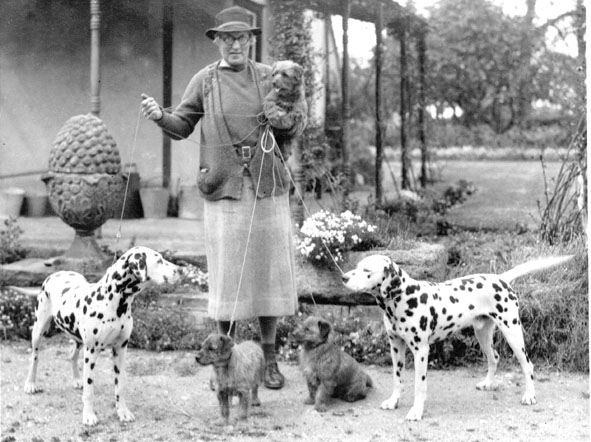
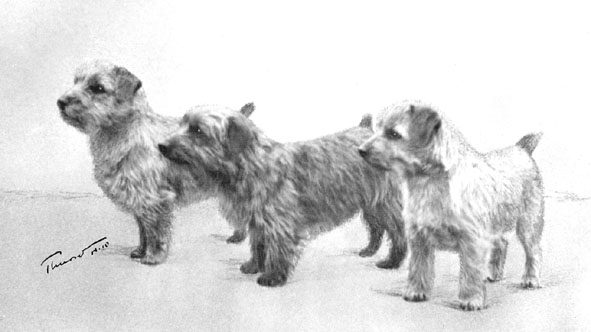
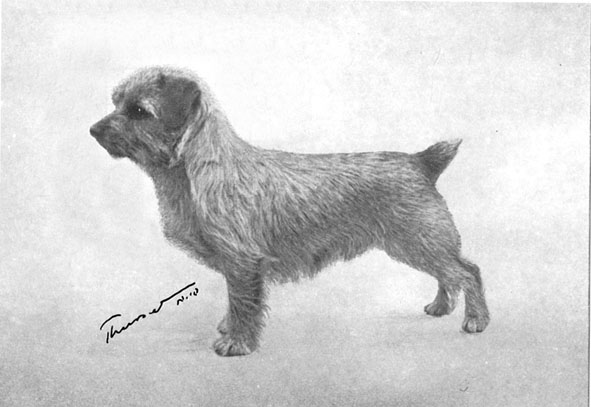
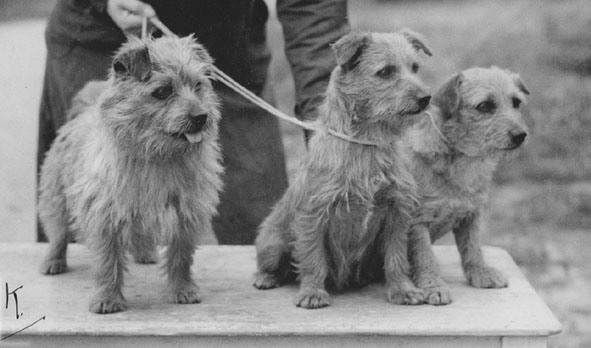
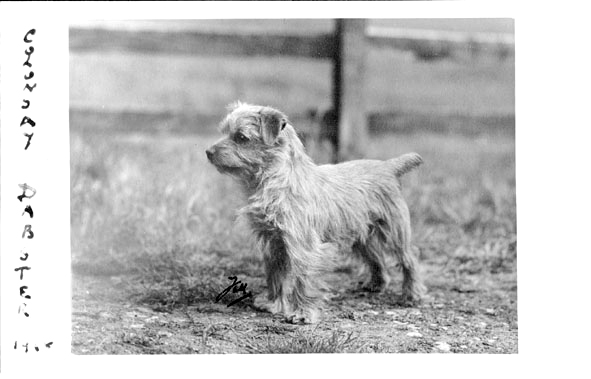

L to R: Colonsay Chippy, Colonsay Junior, ?, Colonsay Musical Box, Colonsay Malush.




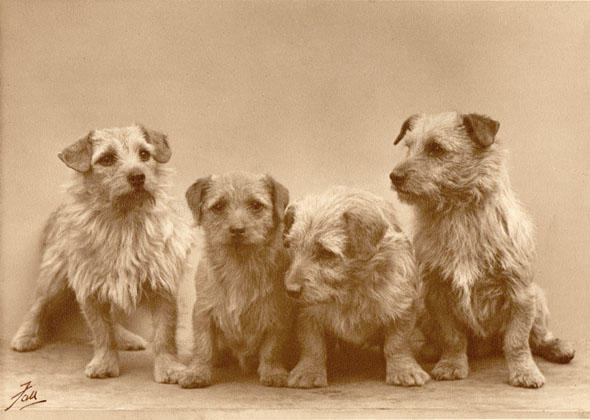
The characters who shaped the Norfolk Terrier in the years leading up to, and after, separation.
A personal reminiscence by Gilean White, Vicbrita Maltese and Norfolk Terriers.
What memories have been stirred up by the opportunity to recall some of the people and dogs who were around during these years.
Miss Macfie was my first contact with a breeder of drop eared Norwich Terriers, or Norfolk Terriers as they have been known since September 22, 1964. It was 1950 and living only ten miles away from Miss Macfie’s Colonsay kennel, we had gone there seeking a replacement for the last of the pair to whom my parents and I had given a home in 1938.
Miss Macfie was certainly a great character with forthright views but a lovely dry sense of humour. Frequently to be seen at shows in her signature tartan skirt and trademark hat, surrounded by a gang of Norfolks who were not averse to mistaking her woollen-stockinged legs for a tree!

It was in large part due to Miss Macfie’s enthusiasm and persistence that drop eared Norwich Terriers were renamed Norfolk Terriers. Many readers will be unaware that in the years before 1964 the allocation of CCs was determined by the numbers of puppies registered. During these years more drop ears than prick ears were registered but the CCs were being won in reverse proportion. At the time of separation there were 56 prick ear champions and only 19 titled drop ears. Differences in type between the ear carriages were also apparent.
Among the Colonsay dogs I remember well were Ch Dixy, Ch Junior, We Three, Flip and his daughter Ch Minx of Furzyhurst.

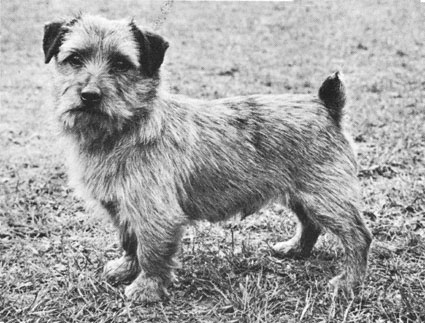
Probably the most famous were Ch C. Banston Belinda and Ch C Orderley Dog, who became the breed record holder under the ownership of Alice Hazeldine. Orderley Dog was in fact bred by Mary ‘Moortop’ Atkinson who is still winning with her Norfolks today.
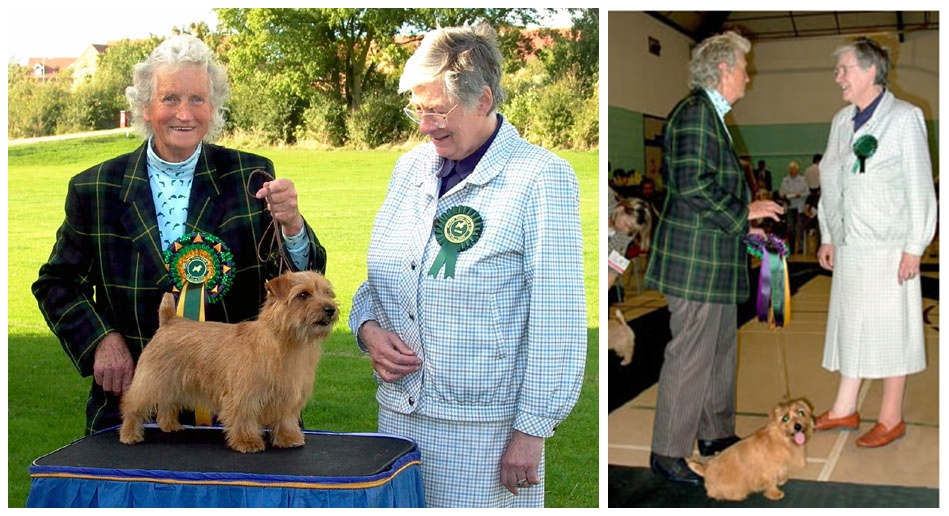
Miss Macfie is credited with keeping the drop ears going during the Second World War and in recognition of her place in breed history she was elected the first and only life president of the Norfolk Club. She died in 1965.
Miss Macfie’s kennel manageress was our good friend May Marshall, then Miss McHale and always known as ‘Auntie May’. She played a very important part in the Colonsay successes and was adored by the dogs.
May was a lady of so many talents, embroidery, gardening and painting, and was an excellent judge of dogs. She and her husband Bill Marshall bred Norfolks under their affix Ravenswing.
Mrs Kirkby Peace – what can I say about dear Rhalou who was named for a Russian princess. She certainly had dogs in her blood as her father had supplied Skyes to Queen Victoria. She was a magical person of great enthusiasm and so interesting to be around. She was somewhat of a ‘Pied Piper’ to both dogs and young people. I was very happy to be called her adopted daughter as she had six sons, and I am proud to have stewarded for her at one of the last shows she judged before her untimely death.
My father and her husband, ‘K’, were veterinary colleagues. Rhalou’s most notable part in Norfolk History all those years ago was as the owner breeder of Kirkby Freddy, sire of the great Ch Ickworth Ready, who was actually bred by Rhalou, and of Ch Colonsay Red Tabs among others.

Mention of Ready leads me directly to his owner Miss Alice Hazeldine, a tall elegant lady of the ‘old school’ who had begun breeding drop ears with Colonsay foundation stock. In her capable hands Ready became a legend in his short lifetime. He won 17 CCs and was the first Norfolk to win championship show placements. At Miss Macfie’s death in 1965 Alice took on the Colonsay kennel and continued showing Ch Belinda, who was sired by Ragus Coxcomb, and also Ch Orderley Dog, a Ch Alder grandson.
(Beware if you stood near Alice at shows with a Norfolk in your arms because, while you talked, she could not help stripping out the odd bit of hair on your dog that she saw as needing a tweak. Sally Willbie)

with Ch Waveneyvalley Alder, W. Gypsy, BG (?), and Ch W. Joy
Victor Page was a real countryman who lived for his dogs, the very successful Waveneyvalley Kennel. I first met him in 1955 when he collected me and my Colonsay Flip daughter at Beccles station in Suffolk and drove me to his house Ashmans Hall, a fine country house with a slightly faded exterior. As we both knelt on the marble floor of the cloakroom to mate the great Ch Waveneyvalley Alder to my bitch, I couldn’t have imagined how one of the resulting puppies would get me so deeply involved with the show scene.
Mrs Page was a gracious hostess but the best thing of all was that trotting around the lunch table was Alder’s sire, the one and only Elel Spruce. He was a small neat dog with a lovely harsh dark red coat; Spruce carried four Colonsays in his immediate pedigree and was also the sire of Ch Gypsy, Ch Aldersister and Ch Joy, all Waveneyvalleys.

Esmee O’Hanlon of the Gotogrounds had founded her kennel on Ch Alder and her dogs created a number of records. Gotoground Vixen was the first drop ear to win BIS all breeds at an open show. Her most famous was Ch Gotoground Widgeon Bunny, a one time record holder with 16 CCs.

Mrs O’Hanlon was a very elegant ‘country lady’ whose dogs were noted for their soundness and were great lasters. Ch G. True Blue came out of retirement to take yet another CC and BOB at eight years old.
You may well be wondering why there is no mention of the Ragus kennel so far. It would be quite impossible not to acknowledge the Ragus dynasty of Marjorie Bunting, her mother Grace Marks, and Marjorie’s daughter Lesley at this stage of the Norfolk’s history. However at the time of separation we must remember that the Ragus kennel was pre-eminently in the prick ears while providing several drop eared kennels with foundation stock which would make those kennels, and the Ragus name, so famous in Norfolks.

Mrs M J Taylor – the amazing Joy – and her Nanfan kennel were still as important at her death in 2006 as they were at separation; so many of us are grateful to Joy for superb foundation stock and for beautifully bred stud dogs. Her all-time great Ch Nanfan Heckle took the first BOB as a Norfolk at Crufts in 1965, his first CC, and he went on to repeat this award twice more.
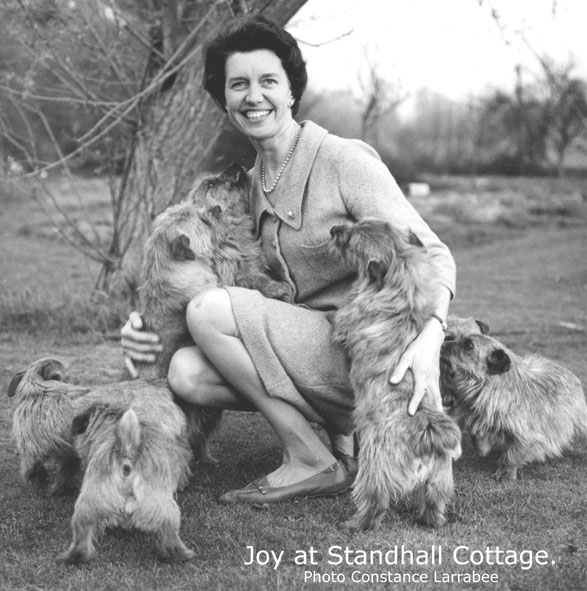


Mrs Southwick of the Hunston kennel in Norfolk was famous for her husband’s remark on opening a crate containing an unexpected black and tan drop ear. He exclaimed ‘Holy smoke, whatever is this?’ Marjorie Bunting described her as ‘a friend to all the breed’ and she certainly had great success as a breeder. Her most famous was probably Ch Hunston Hedge Betty, owned by Mrs O’Hanlon, and Hunston Hedge Warbler, granddam of several Nanfan champions through N.Hayseed.
Major Norman Bradshaw was secretary of the club and one-time treasurer as well. He ran things with the effortless ease one would expect from a military man. His partner in their very successful Withalder Norfolk and Norwich kennel was Reg Finney, who also served the Club as assistant secretary. We enjoyed several Rallies, as the Fun Day was called then, in their lovely garden.
Rosemary Richardson of the Wymbur drop ears became president after Miss Macfie’s death and served for five years. She was a most charming person and another breeder who lived in Norfolk. Her best known dog at this time was Ch Wymbur Lindy Lou, bred by Miss Dove, and one of the few drop ears to win BIS at an open show. Mrs ‘Wymbur’ Richardson was always called ‘Mrs RL’ to distinguish her from Amy Richardson of the Montelimars, who owned Colonsay Pretty Royal.
Others who played a part in Norfolk History in these years were Mrs Woodward of the Bluemarkings, Mrs DM Jones of the Robincotts, Bunny and Louise Hazelgrove of the Donairs and Gloria Morgen of the Edburtons.
We thank and bless them all.
